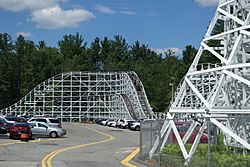Yankee Cannonball facts for kids
Quick facts for kids Yankee Cannonball |
|
|---|---|
 |
|
| Canobie Lake Park | |
| Location | Canobie Lake Park |
| Coordinates | 42°47′43″N 71°14′57″W / 42.79527°N 71.24922°W |
| Status | Open |
| Opening date | 1930 |
| General statistics | |
| Type | Wood – Out and back |
| Manufacturer | Philadelphia Toboggan Coasters |
| Designer | Herbert Paul Schmeck |
| Lift/launch system | Chainlift |
| Height | 19.8 m (65 ft) |
| Drop | 19.4 m (64 ft) |
| Length | 609.6 m (2,000 ft) |
| Speed | 56.3 km/h (35.0 mph) |
| Yankee Cannonball at RCDB | |
The Yankee Cannonball is a classic wooden roller coaster located at Canobie Lake Park in Salem, New Hampshire. It's an "out-and-back" style coaster, meaning it goes out from the station and then comes back along a similar path. This exciting ride first opened way back in 1930!
Contents
History of the Yankee Cannonball
This awesome roller coaster was designed by Herbert Paul Schmeck. He worked for a company called Philadelphia Toboggan Coasters. The coaster was first built in 1930 at a different park called Lakewood Park in Waterbury, Connecticut. Back then, it was simply called "Roller Coaster."
Moving to Canobie Lake Park
After only five years, the coaster moved to its new home at Canobie Lake Park in 1936. When it moved, it was given a new name: "Greyhound." Later, in 1983, it was renamed the "Yankee Cannonball." This name honors the American Civil War.
The coaster's original trains were blue and gray. These colors represented the two sides of the war: the Union and the Confederate armies. The ride's structure was red, white, and blue, showing how everyone could come together on the ride.
When the coaster was moved, parts of it were made a little shorter to fit the new space. It opened at Canobie Lake Park in 1936 and has been running ever since! Even when Hurricane Carol damaged its lift hill in 1954, it was quickly repaired and reopened.
Changes Over Time
Over the years, the Yankee Cannonball has had some updates. Its colors have changed, and parts of the track have been replaced. Today, the ride's main structure is white with orange handrails. One train is red, white, and blue, while the other is green and orange.
In 2013, the Yankee Cannonball received a special award called the Coaster Landmark Award from ACE. This award recognizes its important history and how special it is to roller coaster fans!
Ride Layout and Experience
The Yankee Cannonball has an "out-and-back" layout. This means the track goes out from the station, makes a turn, and then comes back. It forms a basic L-shape, which was common for older wooden coasters. The ride is known for its small hills that give you fun moments of "airtime" (that floating feeling!). It also has turns that are steeply banked, like a race car track.
What to Expect on the Ride
When your train leaves the station, it goes down a small slope and then turns right. Then, you'll climb up the 65-foot tall lift hill. The first drop is the biggest, at 63.5 feet! After that, you'll go over a short hill that gives you a little airtime.
Next, the coaster goes up another hill and makes a 90-degree right turn at the top. You'll then experience two more small airtime hills before a big, steeply banked 180-degree turn. The train then heads back towards the station, going over several "bunny hills" that give you more airtime. Finally, the brakes slow you down, and you turn back into the station. The whole ride lasts about one minute and reaches a top speed of 35 miles per hour.
Ride Trains and Safety
The Yankee Cannonball has two trains, but only one runs at a time. Each train has three cars, and each car can seat six riders (two across in three rows). This means 18 people can ride on one train. The trains were built by the same company that designed the coaster, Philadelphia Toboggan Coasters.
For safety, the trains have headrests and lap bars. In 2003, seat belts were also added. This was done to make the ride even safer after an incident in 2001 where two trains bumped into each other because of an operator mistake. Now, with the added seatbelts, riders are even more secure during their exciting journey!

